Identifying Your Bathroom Faucet: A Comprehensive Guide
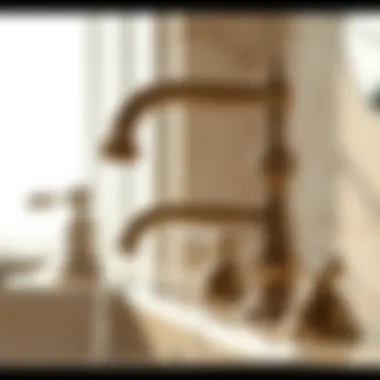

Intro
Bathroom faucets are an integral part of our daily routines, yet they often go unnoticed until they're in dire need of repair or replacement. Whether you’re washing your hands, brushing your teeth, or filling up a basin, the faucet is a critical component that shapes the user experience. Understanding the different types and styles available can transform an ordinary bathroom into a space of comfort and efficiency. This guide aims to shed light on how to identify your bathroom faucet, discuss its various features, and offer maintenance tips to keep it functioning seamlessly.
As we dive into this exploration, it's essential to grasp the underlying trends affecting bathroom design today. From contemporary sleek lines to vintage charm, the faucet you choose reflects not just functionality but also personal taste. So, let’s kick things off by looking at the current trends in bathroom faucet design.
Prolusion to Bathroom Faucets
When we step into the bathroom, we often overlook one of the most crucial elements within: the faucet. A bathroom faucet isn’t just a simple fixture; it plays a significant role in our daily routines. Understanding the different types, functionalities, and designs can not only elevate the aesthetic appeal of your space but also enhance its practical use.
Getting acquainted with your bathroom faucet is like learning the ropes of a well-loved tool in your home. Just as every craftsman knows their tools inside-out, a homeowner benefits from knowing the ins-and-outs of their fixtures. This article aims to empower readers to identify various faucet types and understand their features, ensuring that homeowners make informed choices when it comes to repairs or replacements.
Importance of Identifying Faucet Types
Why should you invest time in figuring out the specific faucet in your bathroom? For one, recognizing what you have can save valuable time when maintenance issues arise. If a leaky faucet is left unchecked, it can lead to water wastage and higher utility bills. Knowing whether it’s a single-handle or double-handle faucet can guide you on the appropriate repairs or adjustments needed to address such issues.
Also, down the road, if you ever find yourself in the market for a new faucet, understanding the styles will help you select one that aligns with your bathroom decor. After all, the right faucet can serve as a stunning focal point or a harmonious accent that ties the room together.
In practical terms, identifying faucet types means:
- Easier repairs: Knowing what kind of faucet you own leads to easier access to the correct replacement parts.
- Enhanced style: You can confidently make choices that match your aesthetic desires and tastes.
- Valuable savings: Reducing the risk of water damage minimizes unforeseen repair costs and maintains your home's value over time.
Ultimately, delving into the specificities of bathroom faucets is entirely worthwhile. Whether you are simply curious about what’s in your home or actively seeking to replace or repair, a good understanding can guide you like a compass in a wilderness. So, with this guide in hand, let’s embark on a journey to demystify the different types of bathroom faucets and what sets them apart.
Understanding Faucet Types
Understanding the various types of bathroom faucets is crucial for both function and aesthetics. A faucet isn’t just a simple outlet for water; it directly impacts the overall look of your bathroom and can even affect your water usage. Different types serve different needs, so knowing what makes each unique helps in making informed decisions when considering a replacement or a new installation.
Single-Handle Faucets
Single-handle faucets are known for their simplicity and convenience. They feature one lever that controls both the temperature and the flow of water, making them an excellent choice for a busy bathroom where efficiency is key. Often found in smaller spaces, they require less installation area and can fit nicely into various design schemes.
- Benefits: Speedy adjustment of water flow, sleek design, and often easier for cleaning due to fewer nooks and crannies.
- Considerations: While single-handle models can be user-friendly, they might not allow precise temperature settings compared to dual-handle systems. In households with children, this could be a factor to think about.
Double-Handle Faucets
As the name suggests, double-handle faucets come equipped with two separate levers—one for hot and the other for cold water. This type allows for greater control over water temperature, which many home users appreciate. It's a design that harks back to more traditional setups but remains popular today.
- Benefits: Exceptional control over water temperature, many aesthetic options available ranging from vintage to modern styles.
- Considerations: They typically require more space than single-handle faucets and could potentially lead to water wastage if both handles are not managed properly.
Wall-Mounted Faucets
Wall-mounted faucets are an interesting choice, as they are directly connected to the wall rather than to the sink itself. These faucets often showcase a minimalist look and can add a unique flair to your bathroom design.
- Benefits: Saves counter space, easier to clean the sink area, and offers a modern aesthetic.
- Considerations: Installation can be trickier, often necessitating professional help, and might require existing plumbing to be rerouted.
Pull-Down Faucets
While often seen in kitchen settings, pull-down faucets are gaining traction in bathrooms. These faucets feature a retractable spout that can be pulled down for greater flexibility in water use.
- Benefits: Excellent reach and usability for various tasks; perfect for rinsing or filling containers.
- Considerations: They generally have a more contemporary look, which may not suit all decor styles. Additionally, the mechanism can sometimes require more upkeep to ensure smooth operation.
Touchless Faucets
Touchless faucets represent the forefront of faucet innovation, utilizing sensor technology that allows for hands-free operation. They are becoming mainstream due to the hygiene benefits they provide, especially in the age of growing health awareness.
- Benefits: Enhanced cleanliness, reduced water usage since they only run when hands are detected, and often an eye-catching modern design.
- Considerations: Touchless faucets usually come at a higher price point and may require batteries or a power source for operation. The technology might not always align with older plumbing systems, making installation a bit of a challenge for some homeowners.
Identifying Your Faucet Type
Identifying your bathroom faucet is not just about knowing where the water comes from; it’s about understanding the nuances of your setup. Grasping the specifics of your faucet type can assist in choosing replacement parts, executing repairs, or simply conducting maintenance. Moreover, it aids in comprehending functionalities and features that can enhance your experience and efficiency in your bathroom. Knowing the faucet type can save you time and headache in finding solutions when issues arise, and it can help you make informed decisions should you decide to upgrade or renovate.
Physical Characteristics
When it comes to physical characteristics, a clear visual inspection can unveil a wealth of information about your faucet. The shape, size, and materials used often tell a story of their own. For instance, a single-handle faucet typically features a streamlined profile with a lever control, while a double-handle design tends to offer a more traditional look with two separate knobs for hot and cold water.
- Material Composition: Most faucets are made of metal such as brass or stainless steel, though some may incorporate plastic components that affect both aesthetics and durability.
- Finish: The finish can also provide clues. Chrome is both common and classic, while brushed nickel might suggest a more modern vibe. If you find an oiled bronze finish, it hints at a more rustic aesthetic.
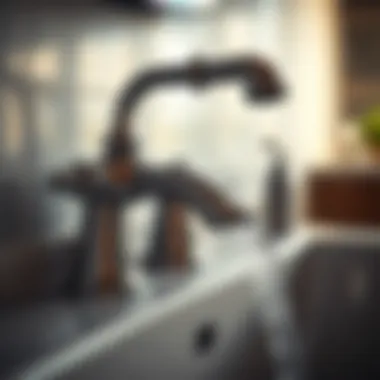
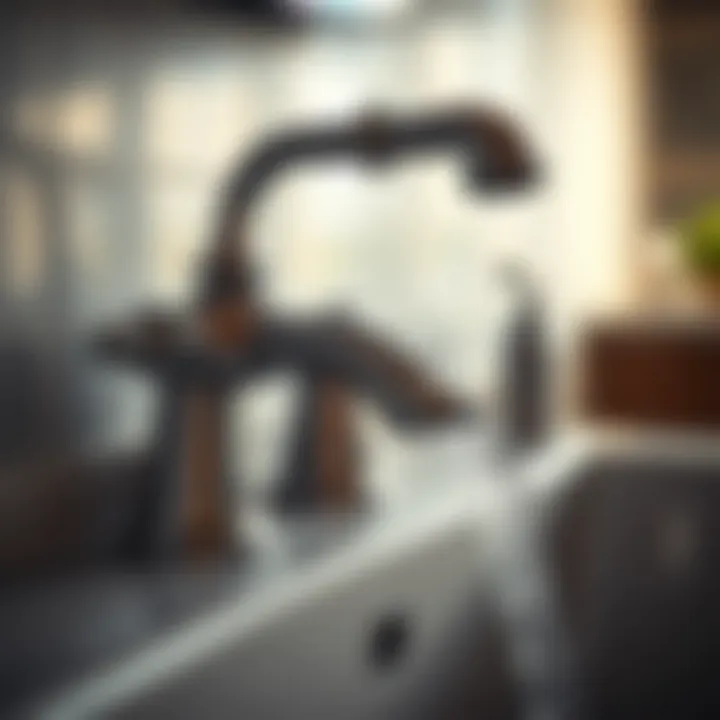
Don’t overlook the ergonomics. Some designs are made for easy manipulation, while others might seem more cumbersome. Knowing these physical aspects not only aids identification but ensures you choose something that’s comfortable and practical.
Installation Method
How a faucet is installed greatly impacts its functionality and accessibility. Faucets can be installed as deck-mounted, which are very common, or wall-mounted, which makes a bold statement. Understanding your faucet's installation method is essential for maintenance or repair work.
- Deck-Mounted: These are attached directly to the countertop and are usually easier to install. Most modern homes feature this installation style.
- Wall-Mounted: Often seen in more vintage or unique setups, wall-mounted faucets require plumbing work behind the wall, making them less accessible for repairs.
If you are considering a replacement, knowing how your faucet was installed might influence your choice of a new one. Some homeowners may prefer to stick with the same installation method, while others might be open to completely altering the plumbing setup.
Spout Configuration
Spout configuration is another crucial factor in identifying your faucet type. The angle and height of the spout can dramatically affect not just the visual appeal but also the overall user experience.
- High Arc Spouts: These provide ample space for washing hands and filling larger items like pots, which is often preferred in modern bathrooms.
- Low Arc Spouts: Typically offer a more traditional look and might be better suited for smaller sinks.
- Pull-Down or Pull-Out: These spouts come with added functionality where the spout can be pulled downward or outward, adding versatility for tasks such as rinsing or cleaning.
Hence, the design of the spout can signify the faucet's intended use and functionality. Understanding the configuration can also help when looking for compatible accessories such as sink mats or faucet-mounted attachments.
Understanding the physical characteristics, installation methods, and spout configurations of your faucet allows for a more tailored and fulfilling bathroom experience.
In summary, identifying your faucet type involves a close examination of physical characteristics, installation methods, and spout configurations. Knowing these elements not only enhances your bathroom aesthetic and usability but equips you with the knowledge needed for repairs and upgrades.
Common Materials Used
Understanding the materials used in your bathroom faucet is essential for both functionality and aesthetics. Faucets are not just utilitarian items; they also play a significant role in the overall look and feel of your bathroom. When considering faucet options, knowing the materials can help you make an informed decision. Here, we discuss three primary types of materials commonly seen in bathroom faucets: metal finishes, plastic components, and ceramic discs.
Metal Finishes
Metal finishes are perhaps the most visible component of any faucet. These finishes not only impact how a faucet looks but also influence its durability and maintenance needs.
- Brass Finish: This material is often favored for its durability and corrosion resistance. It's generally heavier and can withstand the rigors of daily use. Plus, it adds a touch of elegance, fitting well with traditional designs.
- Chrome Finish: Known for its shiny, reflective surface, chrome is popular for contemporary designs. While it’s easy to clean, it can show water spots and fingerprints easily. So, regular maintenance is essential if you want to keep that shine.
- Matte Black Finish: Gaining traction in modern bathroom designs, matte black offers a sleek, sophisticated look. However, it can be more vulnerable to scratches than polished metals.
The choice of metal finish not only complements the design of your bathroom but also determines how much upkeep is needed. Different metals can respond to water quality variations, so it’s wise to consider the specifics of your household’s plumbing.
Plastic Components
While metal is often the star of faucet construction, plastic components shouldn't be overlooked. Many faucets use plastic parts for specific elements due to their lightweight nature and cost-effectiveness. However, what seems like a simple choice can have far-reaching consequences.
- Durability Concerns: Plastic can wear out more quickly than metal, especially if exposed to extreme temperatures or hard water.
- Cost Efficiency: Faucets with plastic components usually cost less, making them attractive for budget-conscious consumers. However, choosing a cheaper option may lead to frequent replacements or repairs.
- Environmental Impact: Many people today are concerned about the use of plastics, which contributes to environmental issues. Look for faucets that are made from eco-friendly plastic materials if this is a priority for you.
Ultimately, while plastic may serve a purpose, it’s worth weighing the pros and cons when selecting your faucet.
Ceramic Discs
Ceramic discs are another vital element in faucets, often found in the cartridge—an integral part that controls water flow. These discs are highly respected in faucet technology for a few compelling reasons:
- Longevity: Ceramic disc cartridges have a longer lifespan compared to rubber washers commonly used in older faucet designs. They don’t degrade as quickly, meaning fewer replacements over the years.
- Smooth Operation: Faucets equipped with ceramic discs provide a seamless user experience. They typically offer a smooth flow and temperature control, enhancing user satisfaction.
- Leak Prevention: With the durable nature of ceramics, these cartridges are less prone to leaks, thus minimizing potential water waste.
In terms of performance, ceramic discs are often seen as top-tier choices offering reliability and efficiency that can save you money and hassle down the line.
For further reading on faucet materials, feel free to check Wikipedia on Faucet Types and How Stuff Works on Faucet Mechanics.
Faucet Functionality and Features
Understanding faucet functionality and features is vital for homeowners seeking to maximize their bathroom experience. This segment sheds light on the diverse elements that enhance both usability and efficiency, ensuring you're not only selecting the right faucet but also understanding how it impacts your daily routines. By examining components like aerators, cartridge types, and flow rate regulations, we can tap into the vast potential these features offer.
Aerators
Aerators are small fittings attached to the end of faucets that mix air with water, providing a smooth and steady flow. The importance of aerators can’t be understated; they help conserve water by reducing the flow rate without sacrificing pressure. This dual benefit not only lowers your water bill but also has a positive impact on the environment.
- Water Conservation: A standard aerator can reduce water usage by up to 50%
- Improved Pressure: By mixing air with water, aerators allow for a stronger stream
Regular maintenance of aerators is crucial too. A build-up of mineral deposits can clog them, leading to reduced performance. Cleaning or replacing an aerator is a simple task, yet it can greatly improve faucet efficiency.
"By simply adding an aerator, you can cut costs while preserving the experience of having a strong flow water!"
Cartridge Types
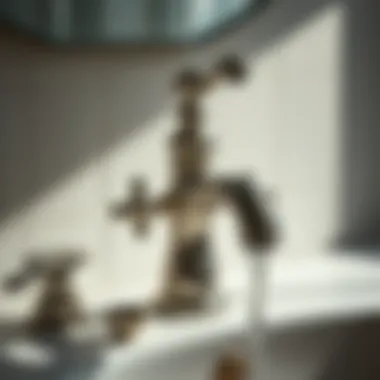
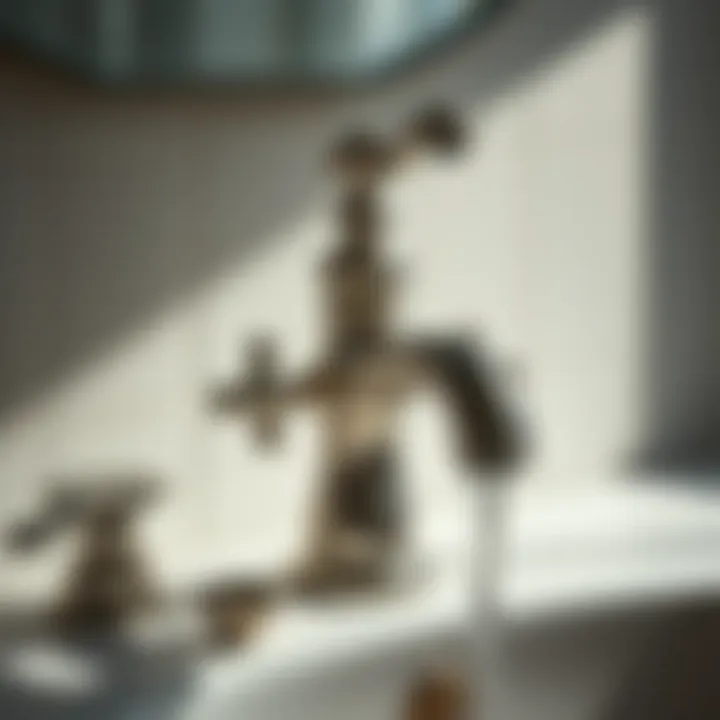
The cartridge within a faucet influences how water flows and adjusts temperature. Different types of cartridges include:
- Compression Cartridges: Often found in older faucets, they use washers that can wear out over time, requiring regular replacements.
- Cartridge Faucets: These provide a more modern solution with fewer moving parts, allowing for smooth operations that require less maintenance.
- Ball Faucets: Usually seen in kitchen faucets, they utilize a single handle to control the flow and temperature.
Each cartridge type has its own pros and cons. Understanding which cartridge suits your faucet can lead to better functionality and longevity.
Flow Rate Regulations
Flow rate regulations are essential to know for both eco-conscious homeowners and those simply looking to save on their water bills. Many jurisdictions impose limits on flow rates of faucets as a sustainability measure. The standard flow rate for bathroom faucets is 2.2 gallons per minute (gpm).
Choosing a faucet that meets these regulations can have several benefits:
- Water Efficiency: Contributes to lower water usage overall.
- Cost Savings: Reduces monthly water expense by limiting excessive flow.
Selecting faucets labeled with WaterSense certification assures that they meet these conservation standards. Such faucets are designed to maintain performance while using less water, making them a sensible choice for today’s environmentally aware consumer.
Overall, a keen understanding of faucet functionality and features can greatly assist in creating a more efficient and pleasant bathroom environment, leading to improved daily experiences.
Considerations for Replacement or Repairs
Replacing or repairing your bathroom faucet can seem like a monumental task, but it doesn't have to be. Understanding various elements of this process is crucial for anyone looking to ensure the longevity and functionality of their fixtures. Whether you are dealing with leaks or simply want to upgrade to something more modern, being informed makes all the difference.
Assessing Damage
The first step in determining if your faucet requires replacement or just a simple repair is to assess any damage. Look for drips, corrosion, or uneven water flow. Sometimes, the issues are more than they appear. Check the supplied hoses and connections—if anything seems worn or cracked, that might be a sign to swap out the entire unit or just parts of it.
Your senses can guide you here; if you hear a hum or clang when turning on the faucet, that might signal underlying issues. It's always wise to pay attention early on to avoid bigger headaches down the road.
Replacement Parts
Sometimes, all you need for a quick fix are replacement parts. Knowing what to look for can save you time and money. Depending on the problem, you might only need a new cartridge, a washer, or an entirely new handle. Many hardware stores provide parts specific to various brands, so make sure to have your faucet's make and model on hand when you shop.
With the right parts, you can make repairs fairly easily. It’s often faster to swap out a part than to take out a whole faucet only to find that you could’ve fixed it with a $5 piece instead. Not to mention, understanding these details can extend the life of your faucet significantly.
Choosing a New Faucet
When you've decided that it’s time to choose a new faucet, there’s more than just cosmetics to consider. You want to make sure any new unit aligns with not just your style, but also your budget and plumbing needs.
Budget Considerations
Setting a budget is non-negotiable when considering a new faucet. It's easy to get caught up in the allure of top-of-the-line designs and water-saving technology, but the price tag can add up quickly. Think about what you’re willing to spend and stick to it.
A sensible approach is to look for faucets that feature good quality at a reasonable price. This is where mid-range brands often shine. You get durability without having to empty your wallet. The key characteristic of budget-friendly faucets is they often have the necessary features without the steep prices of high-end models.
Style Alignment
When it comes to style, your faucet should seamlessly integrate with your overall bathroom aesthetic. From sleek modern lines to classic vintage looks, there’s a wide array to choose from. The challenge is to find a piece that not only fits visually but functionally as well. A good alignment in style enhances not just the look of your bathroom but also your satisfaction with the space.
The unique feature of styling is that it can bring character to mundane spaces. Choose wisely—sometimes focusing solely on the trend may lead you to a product that doesn’t mesh with your personal taste after all.
Compatibility with Plumbing
One often overlooked consideration is whether your new faucet will actually fit with existing plumbing. Problems arise when homeowners assume all faucets will match plumbing layouts, which can lead to costly additional repairs.
This is critical to check because it can save you the hassle of unexpected plumbing alterations. A good characteristic of compatible faucets is their adaptability to common plumbing standards, ensuring they can easily connect without needing excessive modifications. Always review dimensions and connections before a purchase to avoid frustration.
"Understanding your faucet's transformative role in your bathroom can smoothen the maintenance and replacement process."
Being thorough in these considerations will aid you not just in making informed decisions, but also in enjoying a bathroom that functions beautifully for years to come. Make smart choices, and your bathroom fixtures will reward you in spades.
Regular Maintenance Practices
Maintaining your bathroom faucet is not just about keeping it looking spick and span; it's crucial for ensuring its longevity and performance. Regular maintenance practices can help you spot issues early, saving you from headaches down the road. For housewives and homeowners, having a well-functioning faucet means not just convenience but also enhanced home value.
When it comes to faucet upkeep, a few key elements are vital:
- Cleaning: Regular cleaning prevents mineral build-up and keeps the faucet shining.
- Leak detection: Catching leaks early avoids water damage and high utility bills.
- Long-term care: Building habits around faucet care ensures functionality for years to come.
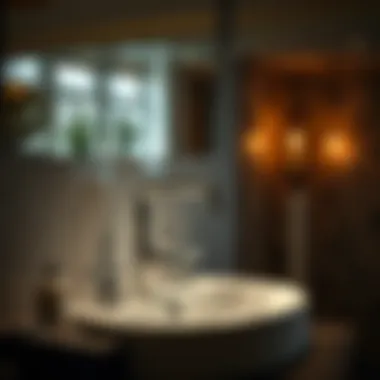
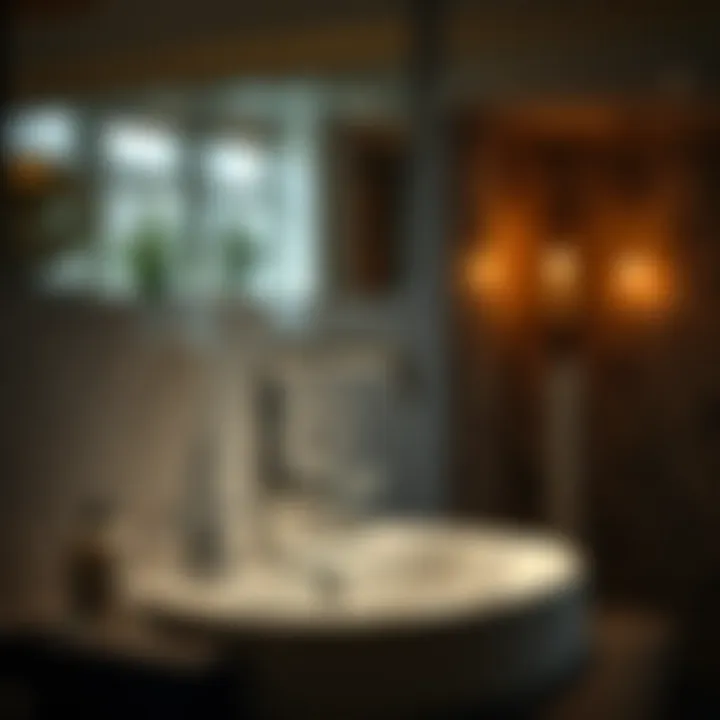
These practices create a routine that keeps your faucet performing optimally, ensuring you always have a reliable water source when you need it.
Cleaning Techniques
Keeping your faucet clean is probably the simplest yet most effective maintenance practice. Daily use can result in water spots and grime. Here's how you can tackle this:
- Daily Wipe-Down: Just grab a soft cloth or sponge and give it a quick wipe after use. It helps prevent water spots.
- Weekly Deep Clean: Use a mixture of vinegar and water for a deeper clean. Soak a cloth in the solution and wrap it around the faucet. Let it sit for a few minutes before rinsing.
- Avoid Abrasives: Steer clear of steel wool or harsh chemicals. They can scratch finishes and create more problems.
Identifying Leaks
A leaky faucet might seem like a minor inconvenience, but it can lead to significant issues if left unchecked. Water can waste and seep into unwanted areas, causing damage. Here’s a step-by-step guide to identify leaks:
- Visual Inspection: Look closely at the base of the faucet and under the sink for water puddles.
- Listen: Do you hear dripping sounds when everything is quiet?
- Check the Handle: If the water continues to flow when the faucet is turned off, you might have a faulty cartridge.
"Spotting issues early can save you the headache of costly repairs later on."
Long-Term Care
Long-term care doesn’t just mean fixing something when it breaks. It’s about building a routine that keeps your faucet in tip-top shape:
- Change Filters Regularly: If your faucet has a filter system, replace it as recommended by the manufacturer.
- Annual Check-Ups: Once a year, take the time to inspect your faucet. Look for signs of corrosion or wear.
- Know When to Call a Pro: If you notice persistent issues that you can’t resolve, it’s better to have a professional take a look.
Regular maintenance not only extends the lifespan of your faucet but also adds to the beauty and functionality of your bathroom. It’s a small effort that yields a big payoff.
Trends in Bathroom Faucet Design
Bathroom faucet design is constantly evolving, reflecting changes in consumer preferences, technology, and overall design aesthetics. Keeping up with the latest trends is essential for homeowners looking to enhance their bathroom experience. These trends not only influence how a faucet looks but also its functionality, sustainability, and overall comfort in daily use.
Aesthetic considerations play a significant role in choosing the right faucet. The market now showcases a rich variety of styles, colors, and finishes that can complement or contrast with existing bathroom décor, offering homeowners the flexibility to express their individual style. In today’s world, it’s less about simply choosing a faucet and more about selecting a piece that acts as a centerpiece in the bathroom.
Moreover, functionality is becoming increasingly important. Consumers are looking for faucets that don't just add aesthetic value but also boast innovative features. This means that more designs are being infused with practicality and convenience, enhancing the overall user experience. Today’s homeowner is very informed, seeking tools that align with their lifestyle while being eco-friendly, thus incorporating water-saving technologies that promote sustainability.
Understanding these trends can help homeowners make informed decisions when upgrading or renovating. This knowledge can empower one to choose faucets that are not only visually appealing but also practical for everyday use.
Popular Aesthetic Choices
In recent years, several aesthetic choices have gained traction among homeowners:
- Matte Finishes: Whether it’s black or brushed brass, matte surfaces provide a modern edge that many find appealing.
- Vintage Styles: Retro faucets with intricate detailing and antique finishes continue to hold their charm, providing a nostalgic touch to bathrooms.
- Colorful Options: Bright colors are making a comeback; faucets in vibrant hues like teal or coral are captivating for those who want a statement piece.
- Minimalistic Designs: Clean lines and simple shapes appeal to those seeking a more modern, uncluttered look.
These aesthetic choices not only enhance the bathroom’s visual appeal but also allow for more personalized expressions of style, something many homeowners cherish.
Technological Innovations
Technology is shaping the bathroom faucet landscape like never before. Here are some innovations changing the game:
- Smart Faucets: Many models now come equipped with touchless sensors to promote hygiene and ease of use. Simply wave a hand, and the water flows – it’s that easy!
- Water Efficiency Features: Faucets with built-in aerators help reduce water consumption without compromising water pressure, aligning with environmental sustainability efforts.
- Integrated Water Filtration: Some designs now include filtration systems that provide clean, fresh water right from the faucet.
- LED Temperature Indicators: Certain models feature LED lights that change color based on the water temperature, ensuring users are aware before they get in touch.
These technological advancements offer a glimpse into the future, showcasing how a small device like a faucet can significantly impact convenience, efficiency, and even safety in the bathroom.
"Trends in bathroom faucet design reflect a confluence of aesthetics and functionality, making each choice a pivotal part of personal space evolution."
Understanding these trends not only enables homeowners to make savvy choices but also positions them to enjoy their bathrooms in ways that are both practical and reflective of their style.
For more insights on the overall impact of these trends, check out resources like Wikipedia or design forums on Reddit.
Ending
As you wrap up your journey into the intricacies of bathroom faucets, the importance of knowing how to identify your faucet system cannot be overstated. It serves as a gateway to not just the aesthetic choices available to enhance your home, but also to practical considerations such as functionality and maintenance. Understanding what type of faucet you have—and the materials and features associated with it—can save you from costly repairs and unexpected frustrations down the line.
Key Elements to Consider
Identifying the faucet type helps in aligning your kitchen or bathroom with modern design trends, while also making sure that any replacements or repairs are hassle-free. With options ranging from single-handle to touchless faucets, each type has its own unique characteristics that might suit your space better than others.
- Material Matters: Knowing whether your faucet is primarily made of brass, plastic, or ceramic can determine its longevity and how much upkeep is necessary. Each material comes with its own set of advantages and drawbacks.
- Understanding Functionality: Features such as aerators and flow rate not only enhance your water’s quality but can also contribute to conserving resources. Familiarizing yourself with these components can contribute positively to both your bathroom experience and utility bill.
- Maintenance Awareness: Regularly keeping tabs on your faucet's condition can prevent leaks and other issues that may arise. This awareness adds to the longevity of your fixtures while ensuring efficiency.
"An ounce of prevention is worth a pound of cure." – Benjamin Franklin
Why It Matters
Ultimately, a well-identified faucet falls in line with a homeowner's goals—creating a stylish, functional, and efficient space. When you are equipped with the knowledge of your faucet's characteristics, you can make informed decisions, resulting in a more enjoyable bathroom experience for both you and your guests.
This guide illuminates the paths that lead to better plumbing decisions, and your diligence in understanding these details will surely pay dividends in the long run. Knowing your faucet isn’t just a minor detail; it’s a crucial step in ensuring your home is the sanctuary you wish it to be.



